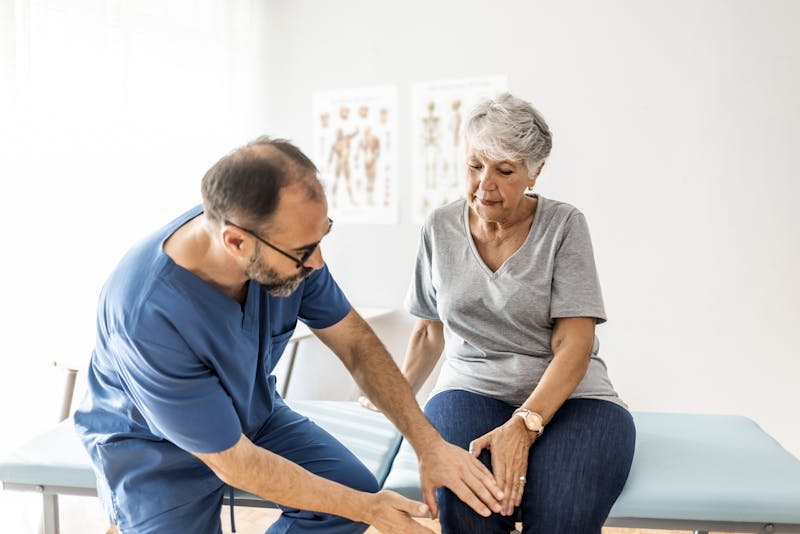Restoring You to YouSchedule Your Consultation Today
Contact Us
Knee osteoarthritis is one of the most common causes of chronic joint pain and disability in older adults. It tends to affect people over the age of 55, especially those with a history of physically demanding work, prior knee injuries, or a family history of arthritis. If you're beginning to experience increasing knee pain, stiffness, or difficulty with daily activities like walking, climbing stairs, or getting out of a chair, you're not alone—and there are effective treatment options available.
What Is Knee Osteoarthritis?
Osteoarthritis (OA) is a degenerative joint disease that occurs when the protective cartilage that cushions the ends of your bones wears down over time. In the knee joint, this cartilage acts like a smooth, gliding surface that allows pain-free movement. When it begins to break down:
-
The bones start to rub against each other.
-
Inflammation develops inside the joint.
-
Joint space narrows, and bone spurs (osteophytes) may form.
-
The soft tissues around the knee become stiff and irritated.
This process leads to the classic symptoms of knee osteoarthritis:
-
Persistent or worsening knee pain, especially with weight-bearing activities
-
Stiffness after rest or in the morning
-
Swelling and joint warmth
-
Reduced range of motion
-
Gradual development of deformity such as bow-legged or knock-kneed appearance
-
Difficulty with walking, standing, or performing routine activities
Left untreated, OA can significantly impact your quality of life, limiting independence and reducing participation in physical and social activities.
Conservative Treatments: The First Step
In the early stages of osteoarthritis, treatment typically focuses on conservative (non-surgical) methods to manage symptoms and slow the progression of the disease. These include:
-
Physiotherapy and exercise to strengthen the muscles around the knee and improve joint function
-
Weight loss, which can significantly reduce stress on the knee joint
-
Pain-relieving medications such as paracetamol or non-steroidal anti-inflammatory drugs (NSAIDs)
-
Knee braces or orthotics to support alignment and reduce strain
-
Injections, such as corticosteroids or hyaluronic acid, to reduce inflammation and lubricate the joint
These measures can be very effective for mild to moderate osteoarthritis. However, as the condition progresses, they may become less helpful.
When to Consider Knee Replacement Surgery
You should consider speaking with an orthopaedic surgeon about knee replacement when:
-
Your pain persists or worsens despite trying conservative treatments
-
You experience daily limitations in walking, climbing stairs, or sleeping due to knee pain
-
You rely on a walking stick or frame to get around
-
Your knee becomes deformed or unstable
-
X-rays show advanced, bone-on-bone arthritis
At this stage, knee replacement surgery becomes a very effective and reliable solution.
How Knee Replacement Surgery Helps
Knee replacement surgery—whether total or partial—involves removing the damaged portions of the joint and replacing them with smooth, artificial surfaces. This eliminates the source of pain and allows for smoother, more comfortable joint movement.
Benefits of knee replacement include:
-
Significant pain relief, often eliminating the need for daily medications
-
Improved mobility and walking ability
-
Greater range of motion and flexibility
-
Better sleep quality due to reduced pain
-
Enhanced independence and participation in daily activities and hobbies
-
Improved overall quality of life
Modern implants are designed to last many years, and outcomes have continued to improve, allowing most patients to return to active, fulfilling lifestyles.
Final Thoughts
Knee osteoarthritis is a progressive condition, but you don't have to live with chronic pain and limitations. Whether you're in the early stages or facing advanced joint damage, the right treatment can help you maintain your independence and enjoy life again. Talk to your doctor or orthopaedic specialist to discuss your symptoms, get appropriate imaging, and find out if a knee replacement might be the next step towards better mobility and less pain.
Author: Mr. Ihsan Mahmood
Mr. Ihsan Mahmood, FRCS (Tr & Orth), PgDip (T&O), CCT (T&O) is a fellowship-trained Consultant Orthopaedic Surgeon specializing in hip and knee replacements at Elanic Hospital. With over 15 years of experience, he employs advanced techniques, including minimally invasive and robotic-assisted surgeries, to deliver personalized, patient-centered care. He serves as Service Lead for Joint Replacements at Forth Valley Royal Hospital.







